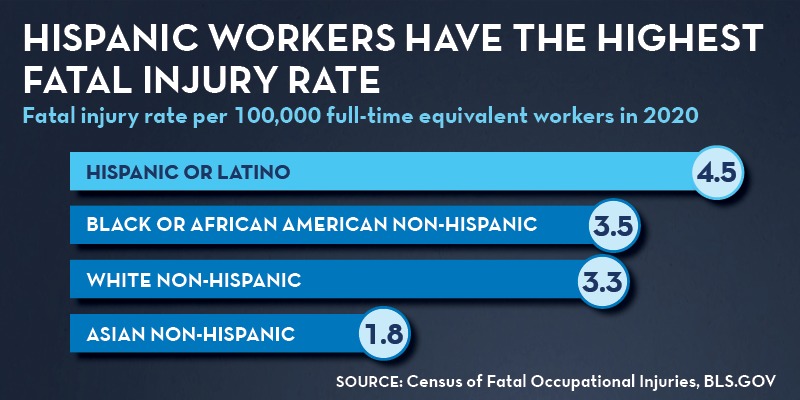
Editor's note: This blog post was first published in 2021 and has been updated in 2022 with the latest data available.
Hispanic workers play a critical role in our nation’s workforce, but are disproportionately impacted by injuries and illnesses while on the job. In 2020, the most recent year for which data is available, more than 1,000 Hispanic or Latino workers died from work-related injuries.
In fact, according to the Bureau of Labor and Statistics, while people of Hispanic or Latino ethnicity made up 18% of the labor force in 2020, they accounted for 22.5% percent of workers who died on the job. According to the AFL-CIO, most fatalities occurred in industries such as construction, agriculture and transportation.
The pandemic also highlighted the disparities that Hispanic workers face: They were hit hardest by COVID-19 in the meat and poultry processing industry, making up 56% of reported cases in 21 states that provided data to the CDC.
National Hispanic Heritage Month is a time to recognize and celebrate the contributions of Hispanic workers to our economic vitality. But these sobering statistics are an important reminder that there’s still much work to do to address the challenges Hispanic workers face in the workplace.

We understand some workers can face an increased risk of work-related injuries and fatalities sometimes because of the jobs they do. But it’s more than that; they may fear retaliation for speaking up about unsafe work conditions, or they may not understand their rights because English is not their first language.
From the first day on the job, every worker is entitled to a safe and healthy workplace free of hazards – regardless of where they’re from or the language they speak. It is every worker’s right to be trained in a language they understand and report a concern about safety or health at work.
Helping employers and workers recognize hazards in their workplaces to prevent injuries and illnesses is one of our top priorities in the Occupational Safety and Health Administration. For example:
- We have information on worker rights and training resources in Spanish and other languages to help keep workers safe and healthy.
- Our collaboration with the Mexican Embassy aims to increase awareness and protect Hispanic and Mexican worker rights.
- We’re hosting stakeholder meetings with Hispanic and Latino communities to better understand how we can improve outreach to workers.
As Hispanics continue to drive labor force growth in the U.S., we need to make sure employers are doing their job so that workers can safely do theirs. We must also ensure that every worker knows about their rights and is empowered to speak-up about concerns in their workplace. We will continue to build on our outreach efforts so they have the protections they deserve, and make sure every worker goes home safe and healthy at the end of each day.
Jim Frederick is the acting assistant secretary for the U.S. Department of Labor’s Occupational Safety and Health Administration. Follow OSHA on Twitter at @OSHA_DOL.

 U.S. Department of Labor Blog
U.S. Department of Labor Blog